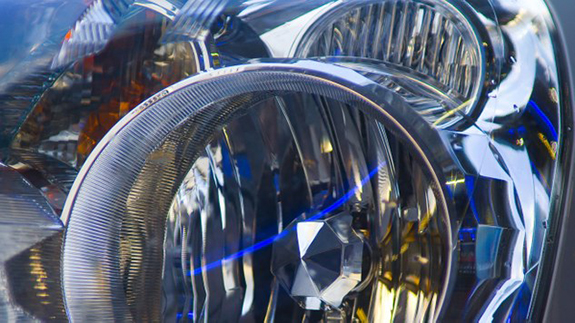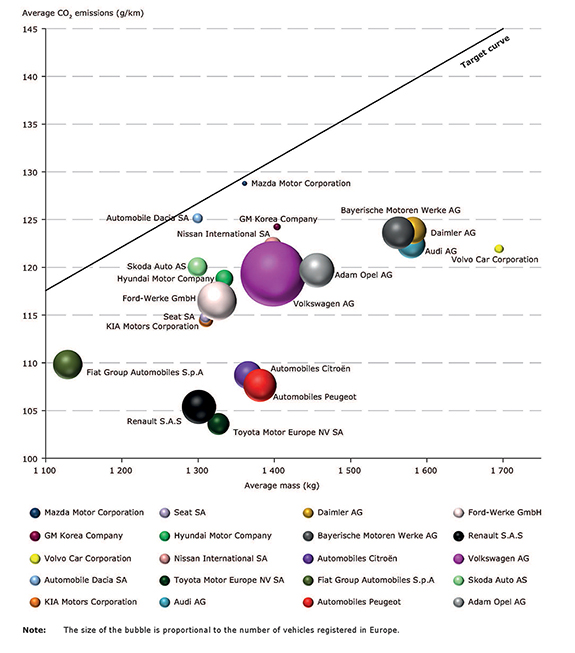All the main carmakers have met their 2012 targets for vehicles’ average carbon dioxide (CO2) emissions, according to the European Environment Agency (EEA). However, most will need to sell increasingly efficient vehicles to meet targets in 2015 and beyond.
 Image © PJ R
Image © PJ R
Car registration data has been analysed by the EEA in the report ‘CO2 emissions performance of car manufacturers in 2012‘. Based on emission levels recorded in vehicle tests, the report shows that in 2012 all major car manufacturers have met their targets for their fleet. Some were already in line with more stringent 2015 targets.
Carbon emissions of the average car sold in the EU fell 2.6 % between 2011 and 2012, cutting the EU average to 132.2 grams of CO2 per kilometre (g CO2/km). This is close to the 130 g target for the average new car sold in 2015.
“The average car sold in the EU is now over 20 % more efficient than a decade ago, which is clearly good news. Carmakers’ rate of progress suggests that future objectives are certainly attainable.”
Hans Bruyninckx, EEA Executive Director
Each manufacturer has a different target, based on the average mass of their fleet, which is gradually phased in, meaning that in 2012 only 65 % of each manufacturer’s fleet needed to meet the target, increasing to 100 % of cars in 2015. By 2020, current legislation states that the average car sold in the EU must not emit more than 95 g CO2/km.
“The average car sold in the EU is now over 20 % more efficient than a decade ago, which is clearly good news,” EEA Executive Director Hans Bruyninckx said. “Carmakers’ rate of progress suggests that future objectives are certainly attainable. At the same time, however, the EEA looks towards a future transition of the mobility system beyond making efficiency gains in internal combustion engine technology.”
Chart: Distance to 2012 target by individual manufacturers

Key findings
– Average emissions of new cars sold in Europe in 2012 were 132.2 g CO2/km, which is 2.6 % lower than the previous year.
– The report defines ‘large manufacturers’ as the 20 companies selling more than 100 000 cars in 2012. Cars sold by these companies made up 94.5% of the total fleet, and emitted 130.4 g CO2/km on average, which is 1.8 g lower than the European fleet average.
– Of the large manufacturers, Fiat had the lowest average emissions (117 g CO2/km). Renault, Peugeot, Toyota and Citroen also had emissions well below the average. At the other end of the scale, Daimler cars emitted 143 g CO2/km on average, with similar emissions levels from cars made by Volvo, Mazda and GM Korea. Compared to 2011, Daimler and Volvo decreased their emission by more than 9 g CO2/km.
– More than 10 % of the vehicles sold by Toyota and Renault emitted less than 95 g CO2/km.
– Manufacturers may meet their targets either individually or as part of a pool of carmakers. Of the manufacturers that missed their individual targets, some were able to meet targets through pooling. When derogations and pools are considered, 74 manufacturers out of 85 met 2012 targets.
– Nine of the larger manufacturers were already compliant with 2015 targets in 2012.
– Although so-called ‘super credits’ give carmakers an advantage for selling electric vehicles or cars with very low emissions, these credits did not influence whether large manufacturers met their targets, the report shows. These credits will be phased out between 2012 and 2016.
– Despite emissions reductions between 2011 and 2012, the average weight of cars increased to 1 402 kg, the heaviest in the last three years.
– There were seven manufacturers selling only electric vehicles in the EU in 2012, according to the report. Larger manufacturers are also involved – in total 20 manufacturers sold electric models in the EU in 2012.
Published : 30 Oct 2013
Courtesy of the EEA







